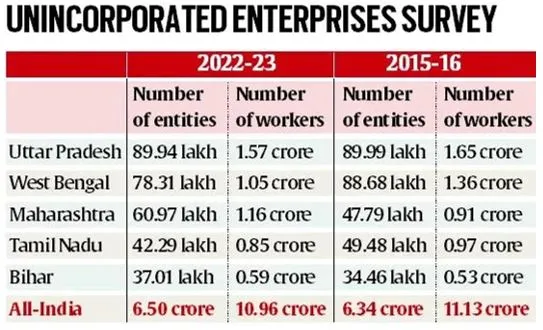

12th July 2024 (9 Topics)
Context
The latest Annual Survey of Unincorporated Enterprises (ASUSE) for 2021-22 and 2022-23, released by the Ministry of Statistics and Programme Implementation, provides key insights into employment trends in India's informal sector.
Key Findings:
The findings reflect the impact of three major shocks (demonetisation, GST implementation, and the Covid-19 pandemic) on unincorporated enterprises and their workforce.
- Employment Figures:
- The number of workers in the informal sector decreased by 16.45 lakh (1.5%) from 11.13 crore in 2015-16 to 10.96 crore in 2022-23.
- The number of unincorporated enterprises increased by 16.56 lakh, rising from 6.33 crore in 2015-16 to 6.50 crore in 2022-23.
- Impact of Shocks:
- The informal sector bore the brunt of demonetisation, GST compliance, and the Covid-19 lockdown, which disrupted economic activities and affected employment stability.
- Maharashtra, Bihar, Gujarat, Madhya Pradesh, and Odisha witnessed an increase in informal sector employment, while Uttar Pradesh, West Bengal, Tamil Nadu, Karnataka, and Andhra Pradesh recorded a decline.
- State-wise Trends:
- Maharashtra saw a consistent rise in informal sector workers, reaching 1.15 crore in 2022-23 from 91.23 lakh in 2015-16.
- Bihar experienced a decline in informal sector workers till 2021-22 but saw a sharp increase to 58.95 lakh in 2022-23, surpassing pre-pandemic levels.
- Economic Indicators:
- The real Gross Value Added (GVA) of unincorporated sector enterprises grew by 6.9% in 2022-23, yet remained 1.6% lower than the 2015-16 levels.
- The sector's compounded annual growth rate (CAGR) contracted by 0.2% between 2015-16 and 2022-23, reflecting the prolonged impact of economic shocks.
- Sectoral Contribution:
- The unorganised sector contributes over 44% to India's Gross Value Added (GVA) and employs nearly 75% of the non-agricultural workforce, highlighting its pivotal role in the economy.

Why the unorganized sector is struggling?
- Cost Burden: The unorganized sector struggles with any changes that increase its costs. Unlike the organized sector, which is largely digitized and formalized, the unorganized sector finds it difficult to adapt.
- Shift in Demand: Demand has shifted from smaller unorganized units to larger organized ones, leading to the rapid growth of organized sector enterprises.
- Market Capture: Despite the intent of GST to formalize the economy, the organized sector often dominates markets that were traditionally held by the unorganized sector.
- Unpreparedness: GST, digitization, and formalization policies disproportionately benefit the organized sector, disadvantaging the unorganized sector.
- Market Capture: As production in the unorganized sector declines, the organized sector expands into new markets, further marginalizing the unorganized sector.
Why unorganised sector matters?
- Dominant Workforce: The sector accounts for approximately 90% of India's workforce.
- Employment Generation: It provides income-earning opportunities to a large number of people who might otherwise struggle to find formal employment.
- Driving Growth: It plays a leading role in India's electric vehicle (EV) growth, particularly through sectors like e-rickshaws.
- Economic Contribution: It plays crucial role in the economy by contributing to:
- National Domestic Product (GDP): Contributes through its output and economic activity.
- Savings: Helps in household savings which contribute to national savings.
- Capital Formation: Supports investment and economic growth by contributing to capital formation.
Government measures to protect interests of unorganised labour
- Life and Disability Cover: Provided through Pradhan Mantri Jeevan Jyoti Bima Yojana (PMJJBY) and Pradhan Mantri Suraksha Bima Yojana (PMSBY).
- Health and Maternity Benefits: Insured under Ayushman Bharat-Pradhan Mantri Jan Arogya Yojana (AB-PMJAY), targeting those in deprived occupations.
- Old Age Protection: Pradhan Mantri Shram Yogi Maan-dhan Yojana (PM-SYM) launched in 2019. It offers a monthly pension of Rs. 3,000 upon reaching 60 years for unorganized sector workers.
- Other Welfare Schemes:
- Public Distribution System, enhanced through One Nation One Ration Card scheme under National Food Security Act.
- Mahatma Gandhi National Rural Employment Guarantee Act (MGNREGA) for rural employment.
- Deen Dayal Upadhyay Gramin Kaushal Yojana for rural skill development.
- Pradhan Mantri Awas Yojana for affordable housing.
- Pradhan Mantri Gareeb Kalyan Rojgar Yojana for employment generation in rural areas.
- Mahatma Gandhi Bunkar Bima Yojana for weavers.
- Deen Dayal Antyodaya Yojana for urban and rural poor.
- PM Street Vendor's AtmaNirbhar Nidhi (PMSVANidhi) for street vendors.
Fact Box:About Annual Survey of Unincorporated Enterprises (ASUSE)
Gross Value Added (GVA)
|
More Articles



